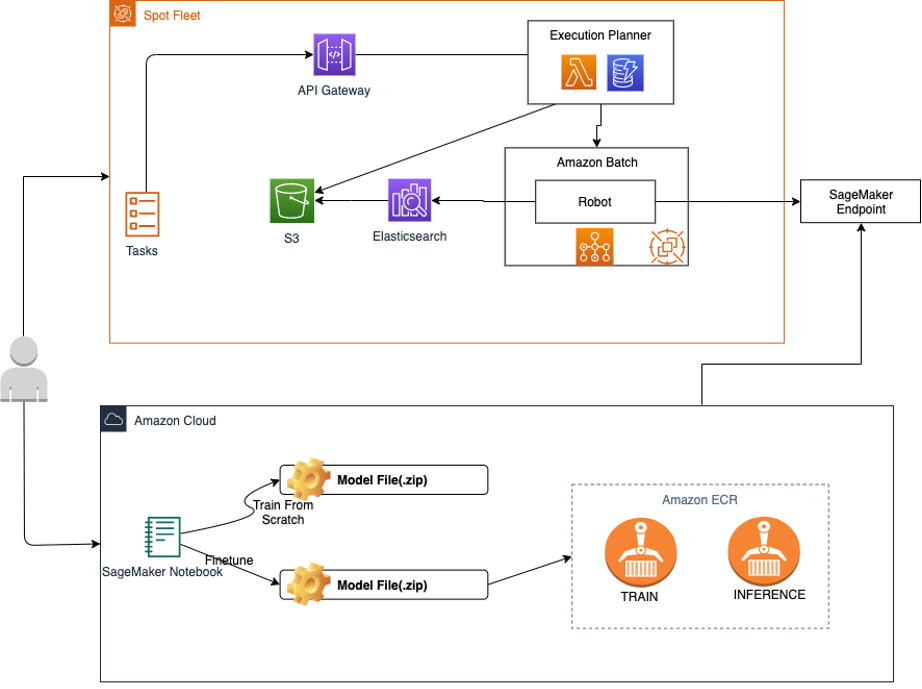What does this Amazon Web Services Solution do?
The Spot Tagging Bot solution enables customers to label digital assets (e.g. unstructured data such as photos, PDF documents, videos, etc.) with machine learning models. Using machine learning technology to label assets helps customers automate their business processes and also create knowledge maps. The solution leverages Amazon Simple Storage Service (Amazon S3) to secure customer's assets and leverages Amazon Elastic Compute Cloud (Amazon EC2) Spot Instances to lower customers’ cost. The solution is an open source framework, customers could use the build-in bots for free or they could also contribute to framework by building their own bot by fine-tuning their own models.
Amazon Web Services Solution Overview
The Spot Tagging Bot solution has two features: the model training feature and the asset tagging feature.
The model training feature allows customers to train their own container-based machine learning model. The trained model will be uploaded to Amazon ECR.
The asset tagging feature allows customers to use machine learning models to process digital assets. All the machine learning tasks run on an Amazon Batch controlled elastic computing platform, which provides resources on demand, releases the resources once completion, and scales automatically based on the task load. The underlying instances that the entire process runs on are Amazon EC2 Spot Instances, which further saves the cost.

Spot Tagging Bot Solution Architecture
- Amazon API Gateway sends request to Amazon Lambda Function.
- Amazon Lambda Function recursively scans all asset file paths in Amazon S3 and generates a task list.
- Amazon Lambda Function saves the list into Amazon Elasticsearch Service (Amazon ES).
- Amazon Lambda Function launches inference endpoint for Amazon SageMaker.
- Amazon Lambda Function launches one or more Amazon Batch jobs through Amazon Step Functions.
- Amazon Batch Job performs the appropriate asset task, reads the source file from the Amazon S3 bucket, and calls Amazon Sagemaker endpoint for reasoning. The reasoning result is written to the Elasticsearch Index, while the recognition result is written to the S3 path customer specified.
This solution currently contains three robots, the Car Model Classification Bot, the Sentiment Analysis Bot, and the Scene Text Recognition Bot.
1. Car Model Classification Bot
The Car Model Classification Bot taking input of the vehicle images, identifies car manufacturer, car model and other information using an image classification model. The model is generated based on AutoGluon, an open-sourced AutoML framework, fine-tuned based on ResNet50 model.
2. Sentiment Analysis Bot
The Sentiment Analysis Bot taking input of Chinese text, identifies sentiment types (positive/negative) in text context using a natural language processing model. The model is a pre-trained and is tuned based on Chinese BERT model.
3. Scene Text Recognition Bot
The Scene Text Recognition Bot recognizes Chinese text information in the print body from images. The bot uses two models to do text recognition, CTPN and CRNN. The bot uses CTPN model to extract the coordinates of the text position, and uses CRNN model to recognize the content of the text.
Spot Tagging Bot
Version 1.0.0
Last updated: 08/2020
Author: Amazon Web Services
Estimated deployment time: 20 min
Features
Easy to Use
Cost Optimization
Open Source & Customization

Browse our portfolio of Amazon Web Services-built solutions to common architectural problems.

Find Amazon Web Services certified consulting and technology partners to help you get started.







